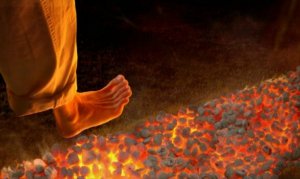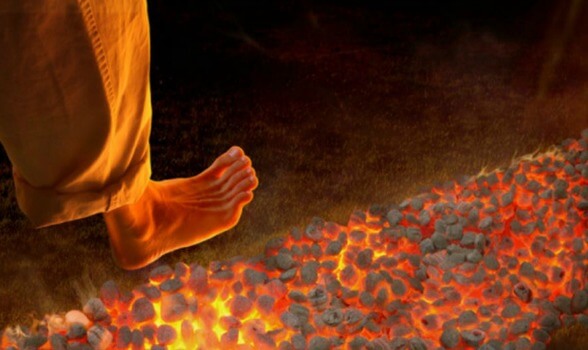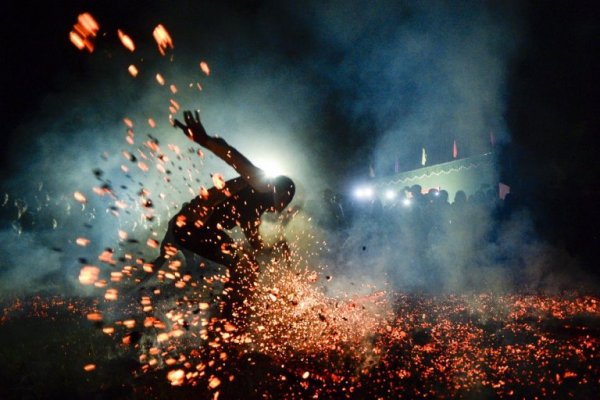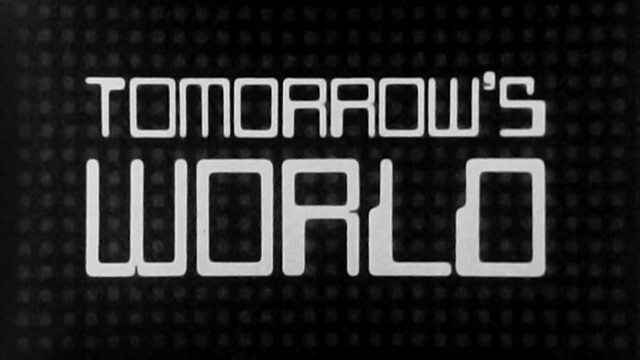Firewalking: A New But Dangerous Motivational Technique


People advertise it as a new technique, but the fact is that the earliest references to this practice of walking on burning coals date back more than 4,000 years. There was a religious ritual like it in India. It was part of ceremonies for healing, initiation, purification, invocations for a good harvest, and many more things.
We know that there are ancient populations that still practice the burning coal walk, like the Kahunas (priests) in certain native Hawaiian groups. Nowadays they walk on burning lava. The natives of the Kalahari Desert in Africa have similar rituals.
So firewalking is anything but new. What happened is that it resurfaced in the United States in the 70’s and started to become popular. Its main proponent was Tolly Burkan, who said he read an article about physics in Scientific American and ever since then he started to walk on hot coals without any problems. He himself has published books and aliens supposedly abducted him.

The fundamentals of firewalking
Proponents of firewalking say that it’s a motivational technique that encourages personal growth. In their minds, it’s a useful tool for increasing your self-confidence, confronting your fears, and boosting your motivation. They take this all from the idea that if you can manage to walk on burning coals you’ll feel more capable, and you’ll have a better image of yourself.
They say that just about everyone is afraid of walking on coals. But the people who overcome that fear and take their first step will be able to take all the next steps too. Apparently, it will ripple out to their daily lives. It’s a “radical change” that eradicates negative beliefs and cultivates the positive kind.
There are also some life coaches who are big proponents and practitioners of firewalking. They usually use metaphors to incorporate positive beliefs about yourself or strengthen them. So walking on the burning coals would be a metaphor for what happens with the rest of challenges you face.
Walking on coals
People who promote firewalking say that both successes and failures with it will affect your mental programming. That is, your values and beliefs. And once that happens, you’ll create an image of what you’re capable of. This then affects your self-confidence.
They say that walking on 900°F coals helps you reprogram your mind. If you can beat this dangerous challenge, you’ll certainly be capable of changing your self-image.

There are three steps in the firewalking process. They are:
- Identification. This consists of exploring your limiting thoughts, defining your personal goals, and figuring out which of your mental programs are keeping you from reaching them.
- Learning. Firewalking intends to help you overcome fears and learn to trust yourself so that you can move forward.
- Change. During this step you feed your desire for change, because it means you learn to break the barriers between you and your goals.
The hope behind firewalking is to help people face up to difficult situations. They want the experience of walking on the hot coals to help you internalize the idea that if you don’t move forward, you’ll get burned. If you don’t keep walking, you will get more hurt. You also have to step confidently and keep going no matter what happens.
Nowadays firewalking is a technique that’s especially common in businesses trying to “empower” their employees. Some examples of businesses that have tried this technique are Microsoft, American Express, and Coca-Cola, among others.
What happens when people walk on coals?
The whole idea is that a person is so mentally strong that they can walk on burning coals and make it to the other side unharmed. That will prove to the participant that they’re stronger and more capable than they think. But from a physical point of view there are some things we just can’t ignore.

According to Luis Alfonso Gámez, a firewalking critic and the author of the article “254 euros to learn to walk on coals,” there’s nothing so great about it. In fact, he says that anyone can do it, that they don’t need any preparation, and definitely don’t need to pay someone money to show them how. He bases these claims on physical facts that we’ll sum up here:
- Walking on hot coals is just like putting out a candle with your fingers. And the candle flame is actually hotter than the coals, because it gets up to temperatures of 1500°F.
- The coal embers aren’t as dense as the human body, and they don’t conduct much heat.
- The process of your foot heating up is very slow and the temperature is very low when you pick up your foot to move forward.
- The promoters of firewalking put a thick layer of ash on top of the embers, which blocks heat transmission.
- Gámez says this supposed life coaching technique is nothing but a scheme to get money out of people. He mentions the skeptic John Nevil Maskelyne, who said that “people with a lot of money and no brains are perfect for the people with a lot of brains and no money.”
An interesting experiment
Richard Wiseman is an English psychologist who wanted to put this controversial motivational technique to the test. On his BBC show, Tomorrow’s World, he did a simple experiment.
He made a carpet of burning coals, but this time he didn’t use firewalking’s standard 15-foot length. Instead, he made one that was 60 feet long. He invited three well-known promoters of this technique to cross the coals on live television.

The first person went up and made it almost 20 feet, but he had to jump off because he was getting burnt. The exact same thing happened with the second person. The third person didn’t want to take part anymore. The first two people had to get medical attention because they had second-degree burns on the soles of their feet.
So Wiseman was able to prove what he’d set out to: “mental strength” ends at about 18 feet. That’s why firewalking gurus use those short distances. They’ve figured out just how long they can make it before people get burnt. No positive thoughts will help you once you’ve made it through 18 feet of burning coals.

A “trick” that still works in the end
Most of us love to dream and believe in that extraordinary things are possible. There are a lot of myths about “the mind’s power,” which might be pretty huge, but not enough to bend the laws of physics. And definitely not after an instructional session that sometimes lasts only 3 hours.
But there are still a lot of people in the world who claim they’ve seen unimaginable results from firewalking. They say their lives changed radically. There are some businesses making statements that their employees improved their performance after walking over the burning coals. Of course there are also plenty of people who come out of the experience burned. “I wasn’t ready,” they say.
Lastly, one of the biggest powers of the human mind is the power to believe, even against all evidence. If you want to believe something and it helps you sort out some kind of discomfort, you’ll take that thing as true. This is the same thing that happens with the placebo effect. At the end of the day, if it makes you feel better, who are we to question it?

People advertise it as a new technique, but the fact is that the earliest references to this practice of walking on burning coals date back more than 4,000 years. There was a religious ritual like it in India. It was part of ceremonies for healing, initiation, purification, invocations for a good harvest, and many more things.
We know that there are ancient populations that still practice the burning coal walk, like the Kahunas (priests) in certain native Hawaiian groups. Nowadays they walk on burning lava. The natives of the Kalahari Desert in Africa have similar rituals.
So firewalking is anything but new. What happened is that it resurfaced in the United States in the 70’s and started to become popular. Its main proponent was Tolly Burkan, who said he read an article about physics in Scientific American and ever since then he started to walk on hot coals without any problems. He himself has published books and aliens supposedly abducted him.

The fundamentals of firewalking
Proponents of firewalking say that it’s a motivational technique that encourages personal growth. In their minds, it’s a useful tool for increasing your self-confidence, confronting your fears, and boosting your motivation. They take this all from the idea that if you can manage to walk on burning coals you’ll feel more capable, and you’ll have a better image of yourself.
They say that just about everyone is afraid of walking on coals. But the people who overcome that fear and take their first step will be able to take all the next steps too. Apparently, it will ripple out to their daily lives. It’s a “radical change” that eradicates negative beliefs and cultivates the positive kind.
There are also some life coaches who are big proponents and practitioners of firewalking. They usually use metaphors to incorporate positive beliefs about yourself or strengthen them. So walking on the burning coals would be a metaphor for what happens with the rest of challenges you face.
Walking on coals
People who promote firewalking say that both successes and failures with it will affect your mental programming. That is, your values and beliefs. And once that happens, you’ll create an image of what you’re capable of. This then affects your self-confidence.
They say that walking on 900°F coals helps you reprogram your mind. If you can beat this dangerous challenge, you’ll certainly be capable of changing your self-image.

There are three steps in the firewalking process. They are:
- Identification. This consists of exploring your limiting thoughts, defining your personal goals, and figuring out which of your mental programs are keeping you from reaching them.
- Learning. Firewalking intends to help you overcome fears and learn to trust yourself so that you can move forward.
- Change. During this step you feed your desire for change, because it means you learn to break the barriers between you and your goals.
The hope behind firewalking is to help people face up to difficult situations. They want the experience of walking on the hot coals to help you internalize the idea that if you don’t move forward, you’ll get burned. If you don’t keep walking, you will get more hurt. You also have to step confidently and keep going no matter what happens.
Nowadays firewalking is a technique that’s especially common in businesses trying to “empower” their employees. Some examples of businesses that have tried this technique are Microsoft, American Express, and Coca-Cola, among others.
What happens when people walk on coals?
The whole idea is that a person is so mentally strong that they can walk on burning coals and make it to the other side unharmed. That will prove to the participant that they’re stronger and more capable than they think. But from a physical point of view there are some things we just can’t ignore.

According to Luis Alfonso Gámez, a firewalking critic and the author of the article “254 euros to learn to walk on coals,” there’s nothing so great about it. In fact, he says that anyone can do it, that they don’t need any preparation, and definitely don’t need to pay someone money to show them how. He bases these claims on physical facts that we’ll sum up here:
- Walking on hot coals is just like putting out a candle with your fingers. And the candle flame is actually hotter than the coals, because it gets up to temperatures of 1500°F.
- The coal embers aren’t as dense as the human body, and they don’t conduct much heat.
- The process of your foot heating up is very slow and the temperature is very low when you pick up your foot to move forward.
- The promoters of firewalking put a thick layer of ash on top of the embers, which blocks heat transmission.
- Gámez says this supposed life coaching technique is nothing but a scheme to get money out of people. He mentions the skeptic John Nevil Maskelyne, who said that “people with a lot of money and no brains are perfect for the people with a lot of brains and no money.”
An interesting experiment
Richard Wiseman is an English psychologist who wanted to put this controversial motivational technique to the test. On his BBC show, Tomorrow’s World, he did a simple experiment.
He made a carpet of burning coals, but this time he didn’t use firewalking’s standard 15-foot length. Instead, he made one that was 60 feet long. He invited three well-known promoters of this technique to cross the coals on live television.

The first person went up and made it almost 20 feet, but he had to jump off because he was getting burnt. The exact same thing happened with the second person. The third person didn’t want to take part anymore. The first two people had to get medical attention because they had second-degree burns on the soles of their feet.
So Wiseman was able to prove what he’d set out to: “mental strength” ends at about 18 feet. That’s why firewalking gurus use those short distances. They’ve figured out just how long they can make it before people get burnt. No positive thoughts will help you once you’ve made it through 18 feet of burning coals.

A “trick” that still works in the end
Most of us love to dream and believe in that extraordinary things are possible. There are a lot of myths about “the mind’s power,” which might be pretty huge, but not enough to bend the laws of physics. And definitely not after an instructional session that sometimes lasts only 3 hours.
But there are still a lot of people in the world who claim they’ve seen unimaginable results from firewalking. They say their lives changed radically. There are some businesses making statements that their employees improved their performance after walking over the burning coals. Of course there are also plenty of people who come out of the experience burned. “I wasn’t ready,” they say.
Lastly, one of the biggest powers of the human mind is the power to believe, even against all evidence. If you want to believe something and it helps you sort out some kind of discomfort, you’ll take that thing as true. This is the same thing that happens with the placebo effect. At the end of the day, if it makes you feel better, who are we to question it?
This text is provided for informational purposes only and does not replace consultation with a professional. If in doubt, consult your specialist.







